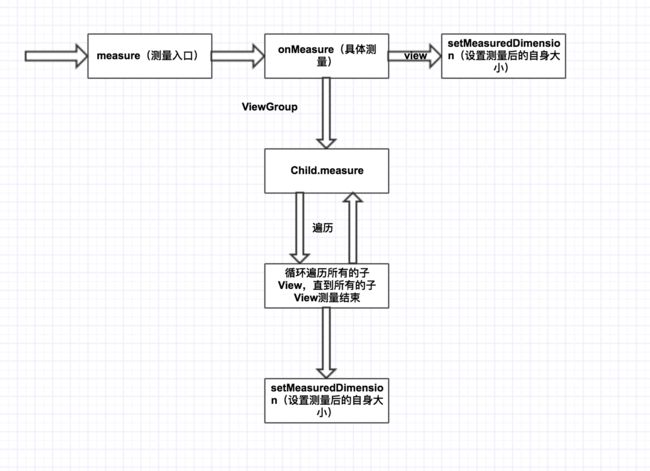onMeasure()方法从字面意思理解就是测量,还有个方法名很相似的方法measure()。其中measure()是View测量的入口,它是一个被final修饰的方法,这意味着无法被子类重写,实质性的工作就是测量出一个View的实际大小,而真正实现测量工作的方法是onMeasure()来完成的,所以具体实现自定义View的测量工作我们是要去实现onMeasure()方法来完成的。
先看下测量的基本流程
关于view的绘制流程,这就要从ViewRoot和DecorView的概念说起。
《Android艺术开发探索》中介绍,ViewRoot对应于ViewRootImpl类,是连接WindowManager和DecorView的纽带,View的三大绘制流程都是通过ViewRoot来完成的。在ActivityThread中,当Activity被创建时,会将DecorView添加到Window中,同时创建一个ViewRootImpl对象,病假ViewRootImpl对象和DecorView对象建立关联。
在开发中不能再子线程进行更新UI的操作,其实质性原因是ViewRootImpl是在UI线程中创建的,而ViewRootImpl在View中对应的是mParent变量,即ViewParent接口。在调用其requestFitSystemWindows, requestLayout, invalidateChildInParent时候,都会调用measure方法。
那么measure到底是用来做什么的呢?
从View的源码中可以知道View的实际大小宽对应的值是mMeasuredWidth,高对应的值是mMeasuredHeight。而measure就是用来计算着两个值用的。
public final void measure(int widthMeasureSpec, int heightMeasureSpec) {
boolean optical = isLayoutModeOptical(this);
//先判断是否有设置为opticalBounds的属性
if (optical != isLayoutModeOptical(mParent)) {
//如果当前的opticalBounds的属性和父类的不一致,就重新计算wdithMeasureSpec和heightMeasureSpec。
Insets insets = getOpticalInsets();
int oWidth = insets.left + insets.right;
int oHeight = insets.top + insets.bottom;
widthMeasureSpec = MeasureSpec.adjust(widthMeasureSpec, optical ? -oWidth : oWidth);
heightMeasureSpec = MeasureSpec.adjust(heightMeasureSpec, optical ? -oHeight : oHeight);
}
// Suppress sign extension for the low bytes
long key = (long) widthMeasureSpec << 32 | (long) heightMeasureSpec & 0xffffffffL;
if (mMeasureCache == null) mMeasureCache = new LongSparseLongArray(2);
final boolean forceLayout = (mPrivateFlags & PFLAG_FORCE_LAYOUT) == PFLAG_FORCE_LAYOUT;
// Optimize layout by avoiding an extra EXACTLY pass when the view is
// already measured as the correct size. In API 23 and below, this
// extra pass is required to make LinearLayout re-distribute weight.
final boolean specChanged = widthMeasureSpec != mOldWidthMeasureSpec
|| heightMeasureSpec != mOldHeightMeasureSpec;
final boolean isSpecExactly = MeasureSpec.getMode(widthMeasureSpec) == MeasureSpec.EXACTLY
&& MeasureSpec.getMode(heightMeasureSpec) == MeasureSpec.EXACTLY;
final boolean matchesSpecSize = getMeasuredWidth() == MeasureSpec.getSize(widthMeasureSpec)
&& getMeasuredHeight() == MeasureSpec.getSize(heightMeasureSpec);
final boolean needsLayout = specChanged
&& (sAlwaysRemeasureExactly || !isSpecExactly || !matchesSpecSize);
//窗体需要强制刷新的时候,如果是不用measure cache,那么需要调用onMeasure方法进行进行view的width和height。如果有measure cache,那么只需要拿到measure cache里的值进行更新就可以了。
if (forceLayout || needsLayout) {
// 首先清除测量的尺寸标记。
mPrivateFlags &= ~PFLAG_MEASURED_DIMENSION_SET;
resolveRtlPropertiesIfNeeded();
int cacheIndex = forceLayout ? -1 : mMeasureCache.indexOfKey(key);
if (cacheIndex < 0 || sIgnoreMeasureCache) {
//测量我们自己,这应该设置测量尺寸标志回来(重新调onMeasure)
onMeasure(widthMeasureSpec, heightMeasureSpec);
mPrivateFlags3 &= ~PFLAG3_MEASURE_NEEDED_BEFORE_LAYOUT;
} else {
long value = mMeasureCache.valueAt(cacheIndex);
// Casting a long to int drops the high 32 bits, no mask needed
setMeasuredDimensionRaw((int) (value >> 32), (int) value);
mPrivateFlags3 |= PFLAG3_MEASURE_NEEDED_BEFORE_LAYOUT;
}
// flag not set, setMeasuredDimension() was not invoked, we raise
// an exception to warn the developer
if ((mPrivateFlags & PFLAG_MEASURED_DIMENSION_SET) != PFLAG_MEASURED_DIMENSION_SET) {
throw new IllegalStateException("View with id " + getId() + ": "
+ getClass().getName() + "#onMeasure() did not set the"
+ " measured dimension by calling"
+ " setMeasuredDimension()");
}
mPrivateFlags |= PFLAG_LAYOUT_REQUIRED;
}
mOldWidthMeasureSpec = widthMeasureSpec;
mOldHeightMeasureSpec = heightMeasureSpec;
//保存当前的值到measure cache里和重新记录old值,key值是用 widthMeasureSpec和heightMeasureSpec拼凑的64位数
mMeasureCache.put(key, ((long) mMeasuredWidth) << 32 |
(long) mMeasuredHeight & 0xffffffffL); // suppress sign extension
}
当然最主要的还是关注onMeasure方法
onMeasure方法很简单,只有两个流程。先调用getDefaultSize方法获取测View的宽高,在调用setMeasuredDimension指定View的宽高。
protected void onMeasure(int widthMeasureSpec, int heightMeasureSpec) {
setMeasuredDimension(getDefaultSize(getSuggestedMinimumWidth(), widthMeasureSpec),
getDefaultSize(getSuggestedMinimumHeight(), heightMeasureSpec));
}
public static int getDefaultSize(int size, int measureSpec) {
//传递过来的默认大小值
int result = size;
//获取测量模式
int specMode = View.MeasureSpec.getMode(measureSpec);
//获取测量大小
int specSize = View.MeasureSpec.getSize(measureSpec);
switch (specMode) {
//使用默认大小
case View.MeasureSpec.UNSPECIFIED:
result = size;
break;
//使用测量后的大小
case View.MeasureSpec.AT_MOST:
case View.MeasureSpec.EXACTLY:
result = specSize;
break;
}
//返回View的宽或高
return result;
}
protected final void setMeasuredDimension(int measuredWidth, int measuredHeight) {
boolean optical = isLayoutModeOptical(this);
if (optical != isLayoutModeOptical(mParent)) {
Insets insets = getOpticalInsets();
int opticalWidth = insets.left + insets.right;
int opticalHeight = insets.top + insets.bottom;
//为View设置宽高
measuredWidth += optical ? opticalWidth : -opticalWidth;
measuredHeight += optical ? opticalHeight : -opticalHeight;
}
setMeasuredDimensionRaw(measuredWidth, measuredHeight);
}
再看一下传入的参数widthMeasureSpec和heightMeasureSpec
这两个参数实际上是由测量规则和大小组的,它们是一个32位的int值,其中高2位是测量规则,低30位才是测量大小。在ScrollerView雨ListView或者GridView冲突的时候我们通常是重新计算ScrollerView和ListView的宽高。
Integer.MAX_VALUE >> 2 (即int值左移动2位得到最大的测量值,指定模式为AT_MOST)
int height = View.MeasureSpec.makeMeasureSpec(Integer.MAX_VALUE >> 2, View.MeasureSpec.AT_MOST);
SpecMode分为三类
| 模式 | 规则 |
|---|---|
| EXACTLY | 父容器已经检测出 View 所需要的精确大小,这个时候 View 的最终大小就是 SpecSize 所指定的值,它对应于LayoutParams 中的 match_parent 和具体的数值这两种模式 |
| AT_MOST | 父容器指定了一个可用大小即 SpecSize,View 的大小不能大于这个值,具体是什么值要看不同 View 的具体实现。它对应于 LayoutParams 中的 wrap_content |
| UNSPECIFIED | 父容器不对 View 有任何的限制,要多大给多大,这种情况下一般用于系统内部,表示一种测量的状态 。 |
一般可以重写onMeasure对自定义控件指定其大小即可。但是在布局中使用wrap_content属性的时候会失效,只要参考自定义View的wrap_content属性失效即可。
@Override protected void onMeasure(int widthMeasureSpec, int heightMeasureSpec) {
super.onMeasure(widthMeasureSpec, heightMeasureSpec);
int with = MeasureSpec.getSize(widthMeasureSpec);
int height = MeasureSpec.getSize(heightMeasureSpec);
setMeasuredDimension(with, height);
}
在 生命周期中,无法直接得到 View 的宽高信息。
view的宽高尺寸,只有在测量之后才能得到,也就是measure方法执行之后。通常使用View.getWidth()和View.getHeight()方法可以返回view的宽和高对应的值,在Activity的生命周期中不是一开始就能得到这两个值的,因为这此时measure方法还没有被执行,测量还没有完成。
有以下几种常见的解决办法:
- 在 Activity的onWindowFocusChanged 回调中获取宽高。
- view.post(runnable),在 runnable 中获取宽高。
- ViewTreeObserver 添加 OnGlobalLayoutListener,在 onGlobalLayout 回调中获取宽高。
- 先调用 view.measure(0,0),再通过 getMeasuredWidth 和 getMeasuredHeight 获取宽高。传入0,0本质上是用系统框架帮我们测量。
